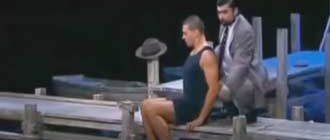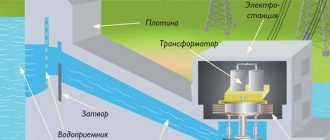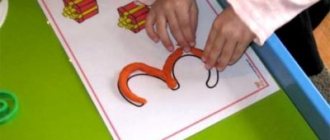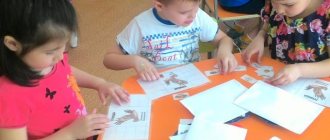Preview:
Municipal budget preschool institution
kindergarten No. 2 Neverkino
Lesson summary on the topic:
“Where there is water, there is life”
(acquaintance with the surrounding world
children of senior preschool age).
- Introduce children to the properties of water (taste, color, fluidity).
- Develop children's curiosity, thinking and speech; introduce the following words into the children's active dictionary: liquid, colorless, tasteless, transparent.
- Give an idea of the importance of water in human life and in nature.
- Foster respect for water.
Equipment: audio recording of surf noise; photographs of desert and forest; water in glasses; teaspoons; salt, sugar, milk; flannelograph, planar model of a river, streams, a person.
Children enter the hall and sit on chairs.
Educator: Children, look what I have in my hands?
Educator: Correct. What do you think the globe is a model of?
Educator: That’s right, this is a model of our planet earth. Tell me what color is the water? And what kind of land? What is more: sushi or water?
Educator: That's right - water.
Educator: Today we are going on a trip. And, since we have to sail along the river, let's choose some type of water transport. What types of water transport do you know? What will we choose? (children's answers: steamship, boat, yacht, cutter, catamaran, etc.) Close your eyes and listen to the water splashing overboard. A journey with several stops awaits us, and here is the first pier. We will stop and remember what we know about water.
1. Marina “Where there is water, there is life”
- What do we use water for every day?
- Why do you need to water indoor plants?
- How many days do you think a person can live without water?
Every living thing, including plants and animals, needs water. Without her, everything dies. For example, a person can live without water for only a few days (from three to seven). Take a look at these two pictures. This is what a desert looks like without water, but this is what the banks of a river or lake look like. (Show pictures.) Well, let's go further, another stop awaits us around the next bend in the river.
2. Pier “Where did the water come to us from?”
Listen to the droplet's story.
Educator: Once upon a time there was a small stream. He ran among forests and meadows. On the way, he met a stranger who was very similar to him.
“Who are you?” he asks.
- I am a trickle. And who are you?
“And I am a stream,” our stream answers. “Let’s be friends and flow on together.” Thus, the waters of many streams merged into one large and beautiful river. It rolls its waters for many kilometers, generously giving water to people along the way. A Man came to the river, admired its clear waters and asked the river to share its gifts. Man installed pumps to pump water from the river and supply it to the water supply system. But no matter how clean the water seemed to Man, grains of sand, particles of silt, and dirt still remained in it. In order to get rid of these “fellow travelers” of water, Man had to build treatment facilities and only after purification send the water on its further journey – to our water taps. This is how I, Droplet, came to you.
A droplet makes such a long and difficult journey, and it becomes precious because it costs a person dearly.
(during the teacher’s words, a river modeling is carried out).
Educator: How is a river born, do you want to know?
(places a wide and long strip of blue paper in front of the children).
The teacher conducts an experiment in water purification (experimental activity).
Educator: Let's try to clean the dirty water together. To do this, take a funnel, put a special filter cloth (made of cotton wool and gauze) into it and start passing dirty water through this funnel. Let's see what we can do?
We will conduct an experiment
We'll find clean water.
We will not allow dirt to pass through the filter,
So they can drink water!
Conclusion: after purification, the water became clean, but it is still not drinkable. It must be boiled and only then will it be suitable for drinking.
Educator: Yes, we cannot live without clean water. We only need clean water! Who else needs fresh water while reading?
Pier "Dance with Cloud"
Educator: A cloud has appeared on the horizon, let's look through our binoculars (children use their hands to make binoculars). Do you see the cloud?
Educator: What does a cloud consist of?
-From droplets of water.
Educator: Do you want to turn into droplets? One, two, three little bits of life.
A dance game is held with children.
Educator: Well, a cloud passed, gave everyone water to drink, nature came to life, and you and I continue our journey.
We stopped and now let’s get to know the water better and do several experiments with it.
Experience No. 1. "Water is a liquid"
Educator: Water is a liquid. It can be poured into anything: a glass, a bucket, a vase. It can be poured, poured from one vessel to another.
Experiment No. 2 “Colorless water”
On the teacher’s table there is a glass of water, a glass of milk, and a spoon.
Teacher: (dips spoon into milk) Guys, can you see the spoon? ( No ) . (puts the spoon in the water) Can you see the spoon now? (Yes).
Educator: What color is the milk? (white) What color is the water? (water has no color, water is colorless).
Experiment No. 3 “Water without taste”
Educator: And now I suggest you guys taste the water. What is she like? Sweet? Salty? Sour? Bitter?
Educator: Water has no taste, it is tasteless. Let's do a little experiment. Let's put the substance that is on our table in a glass of water. Stir and now taste the water. What did it taste like? (children's answers). What do you think I added to the water? (children's answers). It turns out that water can take on the taste of the substance that is put in it.
Today you learned a lot about water. Let's recap what you learned:
Water is a liquid.
Educator: Guys, do you need to save water? Why? (children's answers)
Lesson conclusion: For washing and cooking, only purified water is needed. And to get clean water, people spend a lot of work and effort. This is why you need to conserve water and close the tap tightly.
Source
Cognitive activity “Journey to the world of objects” senior group
Cognitive activity
"Journey into the world of objects"
senior group
Target:
Expand your understanding of the objects of the man-made world.
Tasks:
- Strengthen children's ability to group objects according to purpose: dishes, tools, equipment, items for art.
- Deepen children's knowledge about the history of household appliances: vacuum cleaner, iron.
- Teach children to navigate the past and present of objects.
- Learn to identify the properties and qualities of metal through experimentation; create an algorithm for describing the material.
- Continue learning to compose a coherent story based on a series of pictures.
6.Develop the ability to communicate freely between adults and children.
7.Develop cognitive activity and interest in objects of the man-made world.
8. Strengthen the ability to establish cause-and-effect relationships between the properties and qualities of the material and the method of use.
9.
Cultivate a caring attitude towards objects of the man-made world.
Preliminary work:
- Reading works of fiction.
- Making riddles about objects.
- D\games “What first, what then”, “Why 4”, “Find out the material”, “What are objects made of?”, “Wonderful bag”, etc.
- Examination of encyclopedias, illustrated material, educational screens “Choo-chug, chug-chug, our iron has flared up” (history of the iron)
, “History of the vacuum cleaner”, “History of the stove”.
- Classification (pasting pictures on whatman paper)
household items.
Material:
Two large envelopes - one with the image of “Chamomile” without an address, the other colorful with pictures with the address d\s; letter from Dunno; panel-backpack, with object pictures: plate, spoon, mug; axe, saw, needle; tape recorder, camera, video camera; paints, album, brush (pencils)
.
Music on the disc “Riding a Train”; imitation gate (from soft modules)
with the inscription “Flower City”, signs “Laboratory of Unusual Experiments”, “Museum of Talking Objects”.
Household appliances (toys)
: vacuum cleaner, iron, kettle, coffee grinder, toaster, refrigerator, washing machine, etc.
Stories of the evolution of the iron and vacuum cleaner (in pictures)
.
For children: for each a set of metal objects (coins, plates)
; napkin; container with water; magnet; landscape sheet divided into 6 parts; black felt-tip pen; wooden roundels.
To the teacher: a ready-made algorithm, metal objects.
Easel; screens; a sheet of Whatman paper with three levels “sky”, “earth”, “water”; stickers for various vehicles.
Progress of activities:
1.Organizational moment
The teacher informs the children that an envelope has been sent to our group’s address. He spins it, admires how big and colorful it is, and lets the children look at it.
- What do you think is in the envelope? (children's guesses: surprise, letter)
- Who can write a letter to us? (listens to answers: Carlson, Dunno)
— Do you want to know who the letter is from? (Yes)
. Let's read it!
He opens the envelope and reads the letter:
“Hello, dear guys! I learned from Carlson that you are interested in different subjects! In our Flower City, we love making things up and would love for you to share your finds. I invite you to take a fascinating journey into the world of things. I wish you success. Your friend... Dunno!
Educator:
— Guys, what do you know about Flower City? (children's answers)
. That's right, famous thinkers and famous inventors live there, guys.
— Guys, would you like to accept Dunno’s invitation? (Yes)
To go on a trip, we need to get ready for the trip and put things in our backpack that may be useful along the way.
2.Game exercise for grouping objects
“Pack your backpack for the road.” Children arrange objects on a panel - a backpack - into groups:
Utensils - plate, spoon, mug.
Tools - axe, saw, needle.
Equipment - tape recorder, camera, video camera.
Items for drawing - paints, album, brush.
The teacher invites the children to take one picture from the table, which depicts different objects, and place them in groups.
- Come and arrange it! Be careful!
At the end, the teacher invites the children to check whether the children laid out everything correctly, if there are mistakes, correct them, tell:
— What items did you put in your backpack in one row? Why? How to call it in one word? What are these items needed for on the road? (children's answers)
.
The teacher praises the children for their attentiveness.
Educator:
— Lera, what item did you put in your backpack? What is it for? Why did you place it next to...?
- Well done, Lera, you tried your best and did everything right!
Educator:
- Guys, now we are ready to hit the road! Let's take an empty envelope with us and put everything new and interesting we learn on our trip into this envelope! What will we go on... (a locomotive whistle is heard)
...on a train!
3. Physical exercise “Riding a train”
(children stand one after another, put their hands on each other’s shoulders, make a circle, stop)
The teacher draws attention to the gate with the inscription “Flower City”.
- Well, here we are, we have arrived in the Flower City (reading)
!
Come on in, guys! Guys, this is the “Laboratory of Unusual Experiments” (reading)
. The smartest little guy here, Znayka, must be working on testing his new invention!
- Let's come and take a look!
Educator:
— Guys, what objects do you see on the tray? (children call)
.
What material are they made of? (children's answer: made of metal)
So what are they?
(metal)
.
Educator:
- Let's sit down, guys, and get to know metal better. The children sit down at the table.
4.Experimental - experimental activities
The teacher offers children experimental activities to identify the properties and qualities of metal.
— Guys, what do you want to know about metal? (children formulate the problem)
.
- How are we going to do this? What do we need for this? (children develop a methodology for conducting experiments)
What will we do first, what will we do next?
- If we do this, what will happen? (children predict the result)
The teacher reminds children about safety precautions.
- Let's check your assumptions! Guys, be careful when handling metal objects: you can cut yourself on sharp edges! (children work, identify the properties and qualities of metal)
— Sketch everything you learned about metal? (children sketch an algorithm for the properties and qualities of the metal using symbols)
.
The teacher suggests sketching and telling. Formulating a conclusion (verbal report)
teacher using a ready-made algorithm. The teacher suggests putting the most successful children's algorithm in an envelope.
— Guys, you probably stayed too long? Let's have some tea with you!
5. Physical exercise “The teapot is a grumbler.”
I am a teapot - a grumbler, a busybody, a madman, (we walk in place)
I expose my belly to everyone (hands on the belt, turns the body left - right)
I’m boiling tea, bubbling and shouting: (clap our hands)
- Hey, people, I want to drink tea with you! (jumping in place)
The teacher leads the children to the sign “Museum of “Talking” Objects.”
- Here, guys, are the inventions of the famous mechanics of the Flower City - Vintik and Shpuntik. These items can tell you a lot of interesting things about yourself. Let's come and take a look.
— What miracle technique did you learn? (children list: washing machine, vacuum cleaner, iron, toaster, etc.)
See what these items have in common?
(children's answer: these items make household work easier, they need to be plugged into the power grid, these are electrical appliances)
.
Educator:
— Guys, do you know that household appliances didn’t always look like this? Do you want to know how a person cleaned his home and sorted out his laundry in ancient times? (children's answer: yes)
The teacher suggests taking one picture from the table, examining it, remembering the history of this object, teaming up with those guys who have the same story, standing in order from the most ancient to the most modern. The teacher invites the shy child to use a counting rhyme to choose a group of children who tell the story of their subject.
Vacuum cleaner.
A bunch of branches - a broom
(broom)
- a brush - a cracker - the first cordless roller vacuum cleaner - a modern vacuum cleaner that cleans not only carpets, but also the air.
Iron.
The stone was wound on a rolling pin and held with a “rubel”
(ribbed board)
- the first iron was heated on a stove - “Roaster with coals”
(coals from the stove were poured into the iron)
- a modern iron with temperature regulators, it sprays with steam and sprays.
Praises children.
— Well done, all the guys, they showed and told the history of the objects correctly, they didn’t miss anything!
— Did you like the story of the vacuum cleaner (iron)
?
Do you think objects have changed over time or stayed the same? (children's answer: the person sought to improve them, make them more comfortable and beautiful)
.
The teacher, with the consent of the children, decides to put the stories in an envelope. The teacher informs the children that the journey is coming to an end and it’s time to go back. He offers to take their seats in the carriages. The children return to the music of “Riding the Little Engine”.
The teacher reminds the children of the envelope in which they put all the interesting news about the subjects they learned today.
Educator:
- Guys, what to do with this envelope? What are you offering? (children’s answer: send to Dunno)
The teacher supports the children’s idea, approves, and agrees to write the return address of the Flower City.
6.Independent activity (performing work)
The teacher invites the children to draw pictures of household appliances.
7. Generalization
Educator:
— Did you like our trip? Where would you like to travel next time? (children's statements)
. Praises them for interesting ideas.
The teacher calls the children to the easel.
- If you think that everything worked out for you, that it was easy and interesting for you, then stick a vehicle in the sky that flies.
— If you think that you were mistaken and that something did not work out, then label the vehicles that drive on the road.
— If you didn’t succeed, it was difficult and uninteresting, then stick on water transport.
Children take appropriate transportation and evaluate themselves. Explain their decision.
Abstract of GCD on the surrounding world “Water Sorceress” in the senior group
ALIYEVA ASIYAT
Summary of educational activities on the surrounding world “Water Sorceress” in the senior group
Abstract of the GCD on the surrounding world “ Water Sorceress ” in the senior group .
Program content: introduce children to the properties of water (taste, color, smell, fluidity)
.
Draw children's attention to the importance of water in our lives. To consolidate children's knowledge about where and in what form water exists in the environment .
Develop curiosity, thinking, memory, attentiveness. Vocabulary work: introduce into the children's active vocabulary: liquid, colorless, tasteless, transparent. Get used to answering with a complete answer.
Materials and equipment: Equipment for experiments: glasses of water (according to the number of children, empty glasses, salt, sugar, potassium permanganate, spoons, a basin, vessels of various shapes, a white sheet of paper, cups of milk, napkins, symbols indicating the properties of water.



